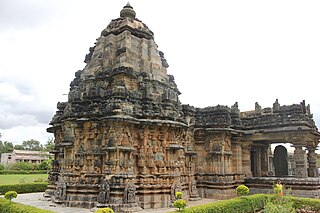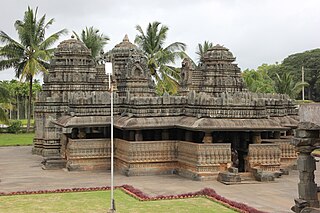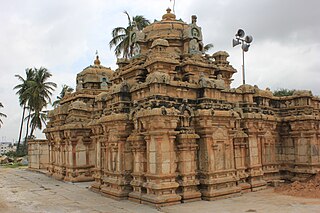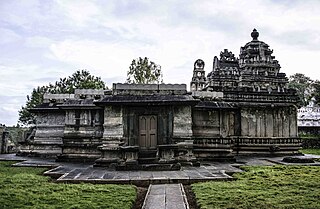
Hoysala architecture is the building style in Hindu temple architecture developed under the rule of the Hoysala Empire between the 11th and 14th centuries, in the region known today as Karnataka, a state of India. Hoysala influence was at its peak in the 13th century, when it dominated the Southern Deccan Plateau region. Large and small temples built during this era remain as examples of the Hoysala architectural style, including the Chennakesava Temple at Belur, the Hoysaleswara Temple at Halebidu, and the Kesava Temple at Somanathapura. Other examples of Hoysala craftsmanship are the temples at Belavadi, Amruthapura, Hosaholalu, Mosale, Arasikere, Basaralu, Kikkeri and Nuggehalli. Study of the Hoysala architectural style has revealed a negligible Indo-Aryan influence while the impact of Southern Indian style is more distinct.

The Someshwara temple, situated in Kolar town of Karnataka state, India, built by Tamil kings Chola.is an ornate 14th century Vijayanagara era Dravidian style construction. Someshwara, another name for the Hindu god Shiva is the presiding deity in the temple. The temple is protected by the Archaeological Survey of India as a monument of national importance.

Panchakuta Basadi is a temple complex located in the Kambadahalli village of the Mandya district, Karnataka state, in southwestern India. It is one of the finest examples of South Indian Dravidian architecture of the Western Ganga variety, related to the Jain faith and iconography.

Western Chalukya architecture, also known as Kalyani Chalukya or Later Chalukya architecture, is the distinctive style of ornamented architecture that evolved during the rule of the Western Chalukya Empire in the Tungabhadra region of modern central Karnataka, India, during the 11th and 12th centuries. Western Chalukyan political influence was at its peak in the Deccan Plateau during this period. The centre of cultural and temple-building activity lay in the Tungabhadra region, where large medieval workshops built numerous monuments. These monuments, regional variants of pre-existing dravida temples, form a climax to the wider regional temple architecture tradition called Vesara or Karnata dravida. Temples of all sizes built by the Chalukyan architects during this era remain today as examples of the architectural style.

The Mahadeva Temple is located in the town of Itagi in Yelburga Taluk, in the Koppal District of Karnataka state, India. It is about 7 km (4 mi) from Kuknur and 20 km (12 mi) from Lakkundi.
Shri Kuruvathi Basaveshwara temple at Kuruvathi is one of the ancient and historic temples at the extreme south-western corner of Hoovina Hadagali taluk, Vijayanagara District, Karnataka, India. This temple is on the bank of Tungabhadra river, 10 km from Halavagalu and 2 km from Mylara and 36 km from Ranebennur and 326 km from Bangalore.

Bucesvara temple, also referred to as the Buceswara, Bucheshwara or Bhucheshvara temple, is a 12th-century Hindu temples in Koravangala village, Karnataka, India. The most sophisticated historical temple in the village, it is considered to be the flag-bearer of Hoysala architecture and was built by a wealthy patron named Buchi during the reign of king Ballala.

The Rameshvara Temple is located in the town of Narasamangala of Chamarajanagar district, Karnataka state, India. The temple was constructed during the 9th century rule of the Western Ganga Dynasty of Talakad.

The Kalleshwara temple is located in the town of Hire Hadagali of the Hoovina Hadagalitaluk in Bellary district of Karnataka state, India.

The Kalleshvara temple is located in the town of Ambali in Bellary district of Karnataka state, India. According to an Old Kannada inscription placed in the sabhamantapa, the temple was constructed during the reign of the Western Chalukya Empire King Vikramaditya VI. This temple is protected as a monument of national importance by the Archaeological Survey of India.

The Mallikarjuna temple is located in the town of Kuruvatti in the Bellary district of Karnataka state, India. The temple was constructed in the early 12th century rule of the Western Chalukya Empire. The temple is protected as a monument of national importance by the Archaeological Survey of India.

The Kaitabheshvara temple is located in the town of Kubatur, near Anavatti in the Shimoga district of Karnataka state, India. The temple was constructed during the reign of Hoysala King Vinayaditya around 1100 AD. The Hoysala ruling family was during this time a powerful feudatory of the imperial Western Chalukya Empire ruled by King Vikramaditya VI. According to the Archaeological Survey of India, the architectural signature of the temple is mainly "Chalukyan". Art historian Adam Hardy classifies the style involved in the construction of the temple as "Later Chalukya, non mainstream, far end of spectrum". The building material used is soapstone The temple is protected as a monument of national importance by the Archaeological Survey of India.

The Kedareshvara temple is located in the town of Balligavi, near Shikaripura in the Shimoga district of Karnataka state, India. Dotted with centres of learning (agrahara), Balligavi was an important city during the 11th - 12th century Western Chalukya rule. The term Anadi Rajadhani used in medieval inscriptions to describe this town tells a tale of great antiquity. Art historian Adam Hardy classifies the style involved in the construction of the temple as "Later Chalukya, non mainstream, relatively close to mainstream". He dates the temple to late 11th century, with inscriptional evidence of additions made up to 1131, by the Hoysalas during their control over the region. The building material used is soapstone. The Archaeological Survey of India classifies the style of architecture as distinctly Hoysala. The Hoysala ruling family was during this period a powerful feudatory of the imperial Western Chalukya Empire, gaining the trappings of independence only from the period of King Vishnuvardhana. The temple is protected as a monument of national importance by the Archaeological Survey of India.

Kedareshwara Temple is a Hoysala era construction in the historically important town of Halebidu, in the Hassan district of Karnataka state, India. It is located a short distance away from the famous Hoysaleswara Temple. The temple was constructed by Hoysala King Veera Ballala II and his Queen Ketaladevi, and the main deity is Ishwara. The temple is protected as a monument of national importance by the Archaeological Survey of India.

The Nageshvara temple complex is located in Begur, a small town within the Bangalore urban district of Karnataka state, India. From inscriptions, it is known that Begur was once called Veppur, and Kelele. Two shrines within the temple complex, the Nageshvara and Nageshvarasvami were commissioned during the rule of Western Ganga Dynasty Kings Nitimarga I and Ereyappa Nitimarga II. The remaining shrines are considered a later day legacy of the rule of the Chola Dynasty over the region. An Old Kannada inscription, dated c. 890, that describes a "Bengaluru war" was discovered in this temple complex by the epigraphist R. Narasimhachar. The inscription is recorded in "Epigraphia Carnatica". This is the earliest evidence of the existence of a place called Bengaluru.

The Rameshvara temple is a 12th-century Shiva temple in Kudli, Shimoga district, Karnataka India. It is an early non-ornate, Hoysala construction with simpler Vesara style. The village of Koodli – also spelled Kudli, Kudali – was a major town through the 14th-century and of great antiquity, with ruins of over eight major Hindu temples and monasteries. It is located about 18 kilometres (11 mi) north-east of Shimoga city, the district headquarters. The town gets its name because it is situated at the confluence of the Tunga and Bhadra tributaries that form the Tungabhadra river.

Akkana Basadi is a Jain temple (basadi) built in 1181 A.D., during the rule of Hoysala empire King Veera Ballala II. The basadi was constructed by the devout Jain lady Achiyakka, wife of Chandramouli, a Brahmin minister in the court of the Hoysala king. The main deity of the temple is the twenty-third Jain Tirthankar Parshwanath. The temple is protected as a monument of national importance by the Archaeological Survey of India. It is part of an Archaeological Survey of India Adarsh Smarak Monument along with other temples in the Shravanabelagola group of monuments.

Bhoganandiswara Temple and Arunachaleswara Temple are a twin Hindu temples complex located in Nandi village in Chikkaballapur district of Karnataka, India. Ornate, beautifully carved and dedicated to Shiva, they have been variously dated between the 9th- to 10th-century CE.

The Arakeshvara Temple, dedicated to the Hindu god Shiva, is located in the village of Hole Alur in the Chamarajanagar district of Karnataka state, India. According to the historian Sarma, the temple which dates back to the middle of the 10th century rule of the Western Ganga Dynasty appears to have been renovated in later periods. It was constructed by King Butuga II around 949 A.D. to celebrate his victory over the Cholas of Tanjore in the historically important battle of Takkolam. It was a military engagement between crown prince Rajaditya, son of the Chola King Parantaka I, and King Butaga II. The temple is protected as a monument of national importance by the central Archaeological Survey of India.

The Bhimeshvara temple is a temple in the town of Nilagunda in the Davangere district of Karnataka state, India.








































